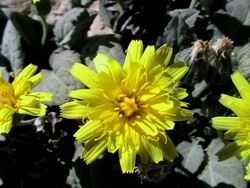Biology:Crepis pygmaea
| Crepis pygmaea | |
|---|---|

| |
| Scientific classification | |
| Kingdom: | Plantae |
| Clade: | Tracheophytes |
| Clade: | Angiosperms |
| Clade: | Eudicots |
| Clade: | Asterids |
| Order: | Asterales |
| Family: | Asteraceae |
| Genus: | Crepis |
| Species: | C. pygmaea
|
| Binomial name | |
| Crepis pygmaea | |
Crepis pygmaea (commonly pygmy hawksbeard)[1] is a species of flowering plant in the genus Crepis in the family Asteraceae.
Description
Vegetative features
The pygmy hawksbeard grows as a perennial herbaceous plant and reaches a height of 5 to 15 centimetres (2.0 to 5.9 in). The stems are arching and ascending, mostly branched, one or more heads, white tomentose or glabrous, often tinged with purple.[2] The plant has few leaves. The above-ground parts of the plant are hairy.[2]
The lower leaves are heart-shaped and usually long-stemmed. The upper leaves are irregularly pinnate with a very large end section and small side sections.[2] The underside of the leaf is often tinged with purple.
Generative traits
The flowering period extends from July to August. The cup-shaped inflorescence has a diameter of about 2 to 3 centimetres (3⁄4 to 1 1⁄4 in) and contains only ray florets. The bracts are bell-shaped, white, and 10 to 15 millimetres (3⁄8 to 5⁄8 in) long.[2] The fruits are 4 to 6 millimetres (3⁄16 to 1⁄4 in) long. The calyx is 7 to 10 millimetres (1⁄4 to 3⁄8 in) long and white.[2]
The chromosome number is 2n = 8 or 12.[3]
Occurrence
The pygmy hawksbeard occurs in the Pyrenees and the western Alps, in Spain , Andorra, France , Switzerland , and Austria.[4] The plant thrives on moist, coarse scree slopes at elevations of 1,500 to 2,900 metres (4,900 to 9,500 ft).
Further reading
- Finkenzeller, Xaver (2002). Alpenblumen. Erkennen & bestimmen. München: Mosaik. ISBN 3-576-11482-3.
- Fischer, Manfred A; Adler, Wolfgang; Oswald, Karl (2005). Exkursionsflora für Österreich, Liechtenstein und Südtirol. 2nd revised and expanded. Linz: Land Oberösterreich, Biologiezentrum der Oberösterreichischen Landesmuseen. ISBN 3-85474-140-5.
References
- ↑ "Crepis pygmaea L.". Plantnet. https://identify.plantnet.org/the-plant-list/species/Crepis%20pygmaea%20L./data. Retrieved 2022-05-17.
- ↑ 2.0 2.1 2.2 2.3 2.4 Template:InfoFlora
- ↑ "Crepis pygmaea", IPCN Chromosome Reports, Missouri Botanical Garden, http://www.tropicos.org/Name/2728009?projectid=9
- ↑ Greuter, Werner (2006). "Crepis pygmaea". Euro+Med Plantbase. http://ww2.bgbm.org/EuroPlusMed/PTaxonDetail.asp?NameId=120113&PTRefFk=7000000.
Wikidata ☰ Q243995 entry
 |


